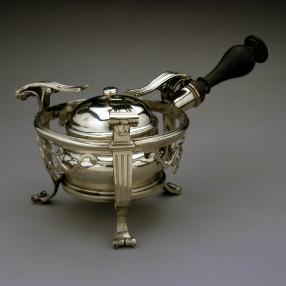Spirit lamp, before 1789
|
|
The spirit lamp consists of two separate elements: a covered container for liquid spirits with a hole for a projecting wick, which could be lighted to provide a low flame; and a stand or frame to hold both the container of liquid and a container of food. The container of the lamp has three parts: a squat, bulbous or baluster-shaped vessel or pot; a flat, screw-on cover for this pot, with a central hole through which a wick can project; and a separate, low, domed lid with a central knob, which extinguishes the flame and covers the lamp. The receptacle for the fluid pot is a circular open framework standing on three feet, with three hinged supports to hold a plate or serving piece, and a turned wooden handle. The framework consists of a wide upper ring, and a narrower lower one. The two rings are soldered to the top and bottom of three tapering supports that terminate in tight scroll feet. The rings are moulded on their outer surfaces, and the upper ring is ornamented as well as reinforced by silver swags cut from the flat and soldered to the lower edge of the ring in three places. The uprights and the hinged plate supports are fluted. All elements of the lamp are stamped profusely with French assay and makers' marks. The pot of the lamp bears Joubert's marks and Paris assay marks; the frame or stand has several blurred or incomplete marks that include Rousseau's mark, Paris assay marks and perhaps a recuse mark (struck when a piece of French silver left France). All of these marks are unclear, to varying degrees, but are identifiable when examined under magnification.
Owned by a descendant of Franklin |
|








